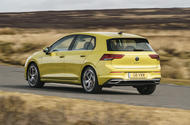E-fuels could essentially allow ICE cars to run with no tailpipe CO2 emissions
E-fuels are way of reducing emissions of existing ICE cars and slower-evolving regions, not alternative to EVs
Volkswagen Group chairman Oliver Blume has said it’s “not up for discussion” that EVs “are the future”, with the firm’s interest in synthetic e-fuels being born of a desire to provide a greener solution for ICE cars already on the road.
Group brand Porsche is currently involved in a major pilot project to sustainability produce e-fuels at a plant in Chile, which would essentially allow ICE cars to run with no tailpipe CO2 emissions.
The European Union is moving towards a ban on new non-zero-emissions cars by 2035, but e-fuels potentially suggest a future for ICE vehicles at that point.
Speaking during the Group’s annual media conference, Blume noted that while it was “a highly emotional debate”, he believed that “the ramp-up of e-mobility and e-fuels are not juxtaposed in any way”.
“When you look at the figures of Porsche, we have a clear commitment towards pushing e-mobility even further,” he said. “It will be the mobility of the future. E-mobility in the near future will be superior to all the ICEs available on the market, so that’s the end of that discussion.”
Blume said that the Group’s interest in e-fuels was instead driven by markets outside of Europe.
“If you look at climate protection as a whole – and this isn’t only a matter for Europeans alone, it’s a worldwide affair – you have to think of what will happen with the 1.3 billion ICEs which are currently available in the market, and that number will continue to grow. They will still be driven around for decades.
“In vessels and planes, we haven’t yet developed a solution, and here synthetic e-fuels offer a feasible alternative to reduce CO2 emissions rather quickly. The advantage is that they can be mixed with traditional fuels, and every single percentage point is of help in this context.
“This is why it’s even more important to come up with clear electrification strategies and fulfil the necessary framework conditions. We need to launch appealing products in the market. We have to offer sustainable sources of energy in different regions of the world, including those regions moving a bit slower, such as South America, Africa and India. Here everything will take much longer than it does in Europe. And that is why new solutions need to be found.
“We have to do both simultaneously but separate the two markets in the discussion, because we’re not competing with each other. You know, you can ramp up e-mobility in some regions and also take care of those regions that contribute to climate change. Some fuels are more inefficient than others, that’s not a secret. But if you produce them in those regions of the world where sustainable energy is available without any limits, then this argument can’t be used any longer.”
Source: Autocar
